

The 3 basic rock types. Ask GeoMan...

What are the 3 basic types of rocks? Just as any person can be put into one of two main categories of human being, all rocks can be put into one of three fundamentally different types of rocks. They are as follows: Igneous Rocks Igneous rocks are crystalline solids which form directly from the cooling of magma. This is an exothermic process (it loses heat) and involves a phase change from the liquid to the solid state. The 3 basic rock types. Radioactive Dating. Evolution and the Fossil Record by John Pojeta, Jr. and Dale A. Springer.
Dating the Fossil Record (Previous Page || Next Page) The study of the sequence of occurrence of fossils in rocks, biostratigraphy, reveals the relative time order in which organisms lived.
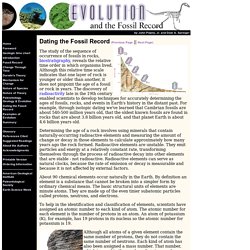
Although this relative time scale indicates that one layer of rock is younger or older than another, it does not pinpoint the age of a fossil or rock in years. The discovery of radioactivity late in the 19th century enabled scientists to develop techniques for accurately determining the ages of fossils, rocks, and events in Earth's history in the distant past. For example, through isotopic dating we've learned that Cambrian fossils are about 540-500 million years old, that the oldest known fossils are found in rocks that are about 3.8 billion years old, and that planet Earth is about 4.6 billion years old.
TropicalConnections_GeologicalTimeWithMajorEvolutionaryEventsInFossilRecord_KruczynskiFletcher.pdf. Geologic and Biological Timeline of the Earth. Astronomical and geological evidence indicates that the Universe is approximately 13,700 million years old, and our solar system is about 4,567 million years old.
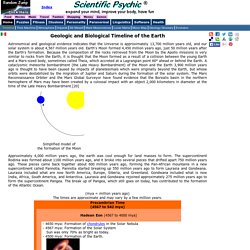
Earth's Moon formed 4,450 million years ago, just 50 million years after the Earth's formation. ThePlanetWeLiveOn-Chapter4.pdf. Formation of Fault Block Mountains. Fault block mountains are distinguished by great sheer rock faces.

These form when enormous underground pressure forces a whole rock mass to break away from another. The line at which this break takes place is called a fault. Geology Cafe.com. Behavior of the Lithosphere: (Crust and Upper Mantle) Subdivisions used in geologic discussions relating to "Plate Tectonics Theory" (discussed below) include:
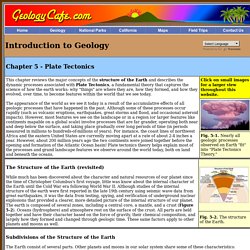
Spreading center. Rift valley. A rift valley forms where the Earth’s crust, or outermost layer, is spreading or splitting apart.
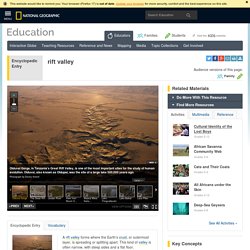
This kind of valley is often narrow, with steep sides and a flat floor. Rift valleys are also called grabens, which means “ditch” in German. While there is no official distinction between a graben and a rift valley, a graben usually describes a small rift valley. Rift valleys differ from river valleys and glacial valleys because they are created by tectonic activity and not by the process of erosion. Rift valleys are created by plate tectonics. Many rift valleys have been found underwater, along the large ridges that run throughout the ocean. 3 types of volcano structures. Scientists describe 10 types of volcanoes but 3 types of volcano structures are most often discussed.
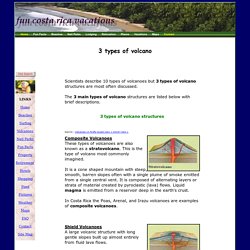
The 3 main types of volcano structures are listed below with brief descriptions. 3 types of volcano structures Source : Volcanoes (A Firefly Guide) isbn 1-55297-683-1. Volcanodiagram. 3. Journey Through Earth. In the style of Jules Verne’s book Journey to the Center of the Earth, take your students on a walk, using sidewalk chalk to mark the boundaries between the different ...
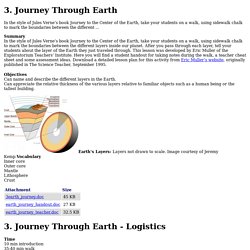
SummaryIn the style of Jules Verne’s book Journey to the Center of the Earth, take your students on a walk, using sidewalk chalk to mark the boundaries between the different layers inside our planet. After you pass through each layer, tell your students about the layer of the Earth they just traveled through. This lesson was developed by Eric Muller of the Exploratorium Teachers’ Institute.
Here you will find a student handout for taking notes during the walk, a teacher cheat sheet and some assessment ideas. Earth's Layers: Layers not drawn to scale. Time10 min introduction35-40 min walk GroupingWhole class Materials. Plate Tectonics Vocabulary flashcards. Tectonic Plates. The edges of these plates, where they move against each other, are sites of intense geologic activity, such as earthquakes, volcanoes, and mountain building.
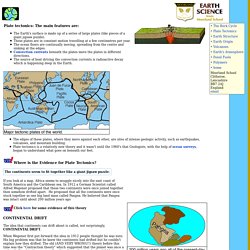
Plate tectonics is a relatively new theory and it wasn't until the 1960's that Geologists, with the help of ocean surveys, began to understand what goes on beneath our feet. Where is the Evidence for Plate Tectonics? It is hard to imagine that these great big solid slabs of rock could wander around the globe. Scientists needed a clue as to how the continents drifted. Plate Tectonics. Ask GeoMan...
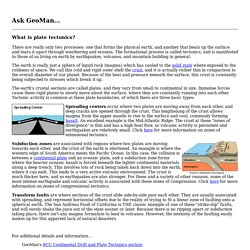
What is plate tectonics? There are really only two processes: one that forms the physical earth, and another that beats up the surface and tears it apart through weathering and erosion. The formational process is called tectonics, and is manifested to those of us living on earth by earthquakes, volcanos, and mountain building in general. The 3 basic rock types. Observing the Three Types of Rocks. The name of a rock reflects certain characteristics. For example, obsidian will resemble glass and scoria will usually be dark red with holes. Rock names also refer to a texture. For example granite will have interlocking minerals and sandstone will have a gritty, sandy feel. Young children need to experience these characteristics before they can internalize the name of a rock. Types of Rocks: The Three Major Rock Groups.
Did you know that lava is molten rock that reaches the earth's surface? Furthermore, did you know that rocks exist in three general forms: igneous, sedimentary and metamorphic? This lesson describes these rock types and examples of each. Explore our library of over 10,000 lessons You now have full access to our lessons and courses, watch the lesson now or keep exploring.
You've watched a video! You took a quiz! You just finished your first lesson. You're making great progress. You've learned so much, but only scratched the surface. Rock Cycle: Igneous, Sedimentary, and Metamorphic rocks. In this lesson, we will discuss the three main types of rocks and how they are formed. The lesson also gives an introduction into how matter locked in rocks can be cycled through the earth. Explore our library of over 10,000 lessons You now have full access to our lessons and courses, watch the lesson now or keep exploring. You've watched a video! Now you are officially smarter, check out the next video or take the quiz to keep learning. You took a quiz! You just finished your first lesson. Geology Kitchen: 3 Types of Rocks - Ms. Shon's Spectacular Science. Earth Structure, Materials, Systems, & Cycles. Geology Cafe.com. Essential concepts of chemistry related to earth materials.